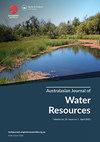An unsustainable level of take: on-farm storages and floodplain water harvesting in the northern Murray–Darling Basin, Australia
IF 2.2
Q2 WATER RESOURCES
引用次数: 7
Abstract
ABSTRACT Water resources for irrigation in the Murray–Darling Basin have been heavily over-allocated, with major detrimental effects on wetlands and rivers. The Murray–Darling Basin Plan is intended to return water from irrigated agriculture to the environment but requires comprehensive, accurate water accounting to achieve this objective. Floodplain harvesting – the diversion and storage of overland flows into on-farm dams – is widely practised by irrigators in the northern Basin. By reducing volumes of river flows, floodplain harvesting has negative effects on downstream water users and the environment. The volume of diversions is not known, creating a major source of uncertainty over water availability and use. We focussed on floodplain harvesting in northern New South Wales (NSW) catchments (Border Rivers, Gwydir, Namoi, Macquarie and Barwon-Darling) because the NSW government is attempting to licence and regulate the practice. We found in 2019–20 there were 1,833 storages in these catchments with a total surface area of 42,650 ha. Storage capacity has risen from 557 GL in 1993–94 to 1,067 in 1999–2000, 1,225 in 2008–09 to 1,393 GL in 2019–20, a 2.5-fold increase in 26 years. We estimated mean annual floodplain harvesting take (2004–2020) in northern NSW was 778 GL (range 632–926 GL). For context, this volume represents half of the mean volume of held environmental water released annually for the entire Basin between 2009–10 and 2018–19 (1,576 GL) and six times that for the northern NSW Basin (125 GL). The volume of take from floodplain harvesting is not sustainable and in breach of legislation on water use and management. We discuss the negative impacts of floodplain harvesting on downstream communities and flow-dependent ecosystems and their social justice implications.不可持续的取水水平:澳大利亚墨累-达令盆地北部的农场蓄水和泛滥平原集水
摘要墨累-达令盆地灌溉用水资源严重超配,对湿地和河流造成了重大不利影响。Murray–Darling流域计划旨在将灌溉农业的水返还给环境,但需要全面、准确的水核算才能实现这一目标。洪泛平原收割——将地表径流分流和储存到农场大坝中——在北部盆地的灌溉者中被广泛采用。通过减少河流流量,洪泛平原收割对下游用水者和环境产生了负面影响。改道的数量尚不清楚,这是水资源可用性和使用不确定性的主要来源。我们专注于新南威尔士州北部集水区(Border Rivers、Gwydir、Namoi、Macquarie和Barwon Darling)的洪泛平原收割,因为新南威尔士州政府正试图对这种做法进行许可和监管。我们发现,在2019-20年,这些集水区共有1833个蓄水库,总表面积为42650公顷。存储容量从1993-94年的557 GL增加到1999-2000年的1067 GL,从2008-09年的1225 GL增加到2019-20年的1393 GL,在26年内增长了2.5倍。我们估计新南威尔士州北部的平均年度洪泛平原收割量(2004–2020年)为778 GL(632–926 GL)。就上下文而言,该水量是2009-2010年至2018-19年间整个流域每年平均释放的环境水量的一半(1576 GL),是新南威尔士州北部流域(125 GL)的六倍。洪泛平原收割的水量是不可持续的,违反了有关用水和管理的立法。我们讨论了洪泛平原收割对下游社区和依赖流量的生态系统的负面影响及其对社会正义的影响。
本文章由计算机程序翻译,如有差异,请以英文原文为准。
求助全文
约1分钟内获得全文
求助全文
来源期刊

Australasian Journal of Water Resources
WATER RESOURCES-
CiteScore
5.10
自引率
21.90%
发文量
25
期刊介绍:
The Australasian Journal of Water Resources ( AJWR) is a multi-disciplinary regional journal dedicated to scholarship, professional practice and discussion on water resources planning, management and policy. Its primary geographic focus is on Australia, New Zealand and the Pacific Islands. Papers from outside this region will also be welcomed if they contribute to an understanding of water resources issues in the region. Such contributions could be due to innovations applicable to the Australasian water community, or where clear linkages between studies in other parts of the world are linked to important issues or water planning, management, development and policy challenges in Australasia. These could include papers on global issues where Australasian impacts are clearly identified.
 求助内容:
求助内容: 应助结果提醒方式:
应助结果提醒方式:


